The 1.5°C Chimera Is Over: We’ll Burn Through the Remaining Carbon Budget by 2027
From apex predator to prisoner of our own heat
We were sold a chimera: a fantasy stitched together from hope and hubris. But the original Chimera was no dream. She was fire-breathing flesh: lion’s head, goat’s body, serpent’s tail. A grotesque hybrid that devoured men whole — but also left scorched earth behind.
Today’s chimera wears a suit. It shows up in net-zero pledges, green growth mantras, and conference stage platitudes about “limiting warming to 1.5°C.” For a while, the world believed in it. A political compromise masquerading as a climate threshold. A number that let nations pretend we could still have it all — growth without limits, fossil fuels without guilt, comfort without consequence.
The monster is real. And the world just keeps feeding it.
At our current rate of emissions, Earth has less than three years before it exhausts the remaining carbon budget that offers even a coin-flip chance of staying below 1.5°C. Not decades — three years.
This isn’t some activist’s blog. This is the verdict of the latest Indicators of Global Climate Change (IGCC) report — a collaborative autopsy by over 60 of the world’s top climate scientists, including former IPCC authors, filling the gap between the IPCC’s sixth assessment (AR6) in 2021 and the seventh assessment, expected in 2028. It confirms what frontline communities already know in their bones: we’re not just brushing up against the 1.5°C threshold — we are barreling toward it.

Think of our planet’s “carbon budget” like a bank account. In 2020, we had 500 billion tonnes of CO₂ we could still emit while keeping global warming at safer levels. But we’ve been spending this money fast: by the start of 2025, the remaining budget had shrunk to 130 billion tonnes, falling by almost three-quarters in five years. And with current global emissions at about 40 billion tonnes per year (like an annual spending rate), we’re set to empty this account by 2027.
Because let’s be honest here for a second: do you really see the world stepping on the brakes of modern convenience and unlimited 5G in the name of ‘carbon budgets’? Yeah, I didn’t think so either.
We are not even close to slowing down. Fossil fuel use is still rising, forests are still falling, and the carbon-intensive bones of our economy are still firmly in place.
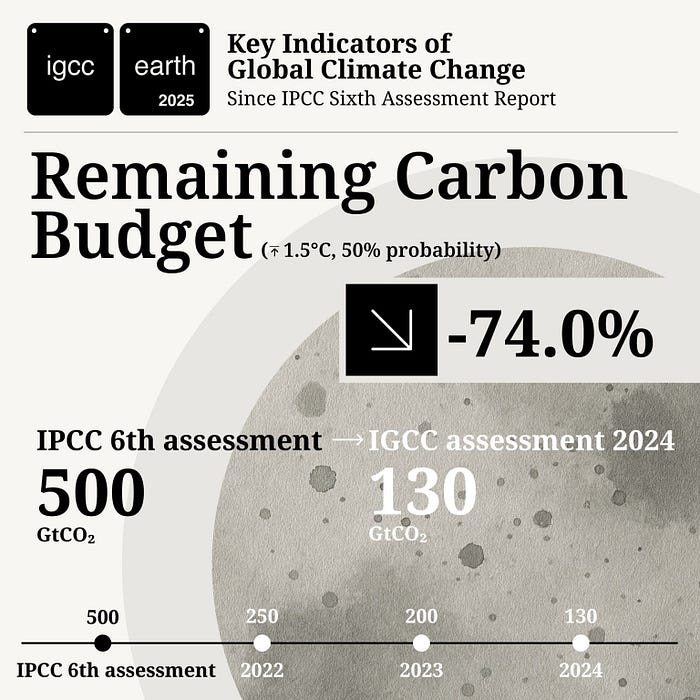
2024 was likely the hottest year in 125,000 years of human history. 2025 now only has a 6% chance to be the warmest year on record, a 50% chance to be the second warmest, and a 43% chance to have an annual average above 1.5 °C. There’s a 70% chance that the five-year average warming will exceed 1.5°C between 2025 and 2029. And for the first time, data suggests even a 1% chance of hitting 2°C within five years.
So yes, the chimera is breathing fire. Not from some mythic cave — but from the scorching fields where crops fail, from glaciers that melt into once-cold rivers, and from songbirds dropping mid-flight in the heat.
We were told 1.5°C was a guardrail. A threshold that, if we stayed below it, might save us. The difference between adaptation and collapse. Between food security and ration lines. Between summer vacations and summer evacuations. But the world didn’t build a bridge. It built a billboard. And now we’re watching the smoke rise behind it.
This is the here and now. So if you’re sweating through one more impossible summer, if the air feels heavier, if your child asks why the trees aren’t green anymore — you already know:
‘Good riddance’ to the 1.5° limit.
The New Baseline: Burning
The height of 2024’s temperatures, with best estimates of 1.52 °C (with a range of 1.39–1.65 °C) above pre-industrial levels, while unprecedented in at least the last 2,000 years, was almost predictable. In fact, scientists now suggest we should consider 2024’s observed temperatures as unexceptional.
Yes, 2024 came after an El Niño year. Sure, waters in the North Atlantic were warmer than average. But the fundamental driver remains clear: as long as we keep increasing greenhouse gas emissions, we’ll keep breaking temperature records. Of that best estimate of 1.52 °C, human activity contributed around 1.36 °C. The rest is the result of natural variability in the climate system. Essentially, it’s like how your own house gets warm: Running your heater (like human emissions) is the main reason for the warmth, while a sunny day (like natural variations) adds a little extra heat. The key difference is that we control the thermostat — and right now, we keep turning it up by adding more greenhouse gases.
But let’s step back. What does 1.5°C actually mean?

Still, global leaders fiddle with definitions. “It’s not officially a Paris Agreement violation,” they say, since that’s measured over a 20-year rolling average. Sure. And your house isn’t officially gone until the flames reach the bedroom. Three single years above 1.5°C could kill the target. Twelve consecutive months may signal the breach is locked in.
Zoom out to the last decade. From 2015 to 2024, average global temperatures were 1.24°C above pre-industrial levels. Of that, 1.22°C was human-caused. Meaning? Virtually all of the catastrophes we’ve seen recently — from killer floods in South Africa and China to heat domes in the US and England — were engineered.
We’re warming the planet at an estimated 0.27°C per decade. That’s faster than at any point in the last two millennia. And over land — where people live, eat, grow, grieve — that number climbs even higher.
It’s a blowtorch.
And the air isn’t just warmer. It’s heavier.
Until When Are We Going to Keep Pretending?
Undoubtedly, these changes are being caused by GHG emissions remaining at an all-time high.
Carbon in the air isn’t some mystery. It’s not a riddle wrapped in greenhouse gases. It’s a receipt. A line-by-line inventory of our choices, from every gas pump to every razed rainforest. Still, we act as though this is unexpected, as if we haven’t spent decades filling the sky with carbon.
Well, there’s now more CO₂ in the atmosphere than at any point in the last 800,000 years. Maybe even the last 30 million. That’s crocodiles-in-the-Arctic territory — only this time, we’re dragging 8 billion humans into a furnace we built ourselves.

Right now, humanity is releasing an average of 53 billion tonnes of CO₂-equivalent per year — that’s everything: carbon dioxide, methane, nitrous oxide. All bundled into one number. All turning the sky into a pressure cooker while politicians debate whether the knob is even real. Because despite all the pledges and press conferences, emissions still haven’t peaked — just the same reckless climb.
To have any shot — even a narrow, limping shot — at keeping warming under 1.5°C without “overshoot”, emissions would need to plunge like a stone. And that, right now, feels as likely as populating Jupiter.
Because we’re addicted to fossil fuels. The ancient dead, dug up and burned to keep us scrolling, shipping, frying, flying. It’s a ritual of combustion, all in service of the short-term convenience we refuse to question. And if it it gets too hot? We burn even more. Energy use is soaring during summer heatwaves, driven by AC units battling against a supercharged atmosphere. We’re burning oil to cool down from the heat oil helped create. Can you understand how absurd is that? Last year, even international aviation — the poster child for emissions collapse during COVID — bounced right back. The sky is filled up again. Not just with planes. With smoke and heat-trapping molecules.
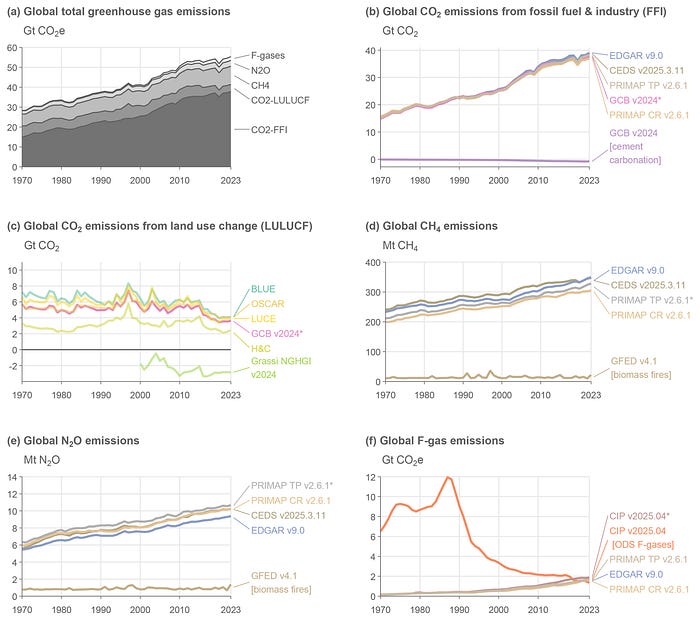
Deforestation? The world is on fire. Methane? Still rising. This gas traps 80 times more heat than CO₂ over two decades. It’s responsible for about 30% of total global warming since the Industrial Revolution. Curbing it could buy us time. But we’re not curbing it. The much-lauded Global Methane Pledge is just that: a pledge. And the trend line still points up.
Meanwhile, the cooling band-aids — human-made aerosols that once masked some of the warming — are thinning. As we clean the air (for good reason), we’re removing the haze that was keeping some of the heat at bay. It’s like smashing a thermometer and pretending the fever’s gone.
The atmosphere is tilting: the sun keeps sending energy in — less is going back out.
In 2024, the total radiative forcing — that is, the energy imbalance between how much heat the Earth absorbs vs. how much it releases — hit 2.97 watts per square meter (9% higher than what the IPCC measured just five years ago), and has now approximately doubled from levels seen in the 1970s and 1980s, for the 2012–24 period. That might not sound like much. But scaled to the entire surface of the planet, it’s like detonating five Hiroshima bombs’ worth of heat every single second.

So, the carbon budget, the amount of CO2 that can be emitted if global warming is to be kept below 1.5 °C? We’ve treated it like a credit card with no limit, making endless promises to pay it back later with technologies that doesn’t yet exist. But there is no “later” anymore. While we spent years calculating and recalculating these numbers, global emissions kept rising. The budget and the 1.5°C limimt were always a chimera — a comforting illusion for the ignorant (me included, obviously) to postpone real action and continue business as usual.
Again: as of 2025, the central estimate sits at 130 billion tonnes. That’s three years of emissions. Max. But it could also be just 30 billion. That’s less time than it takes to launch a new iPhone.
Are we going to keep pretending these numbers matter when we’ve shown no real will to stay within them?
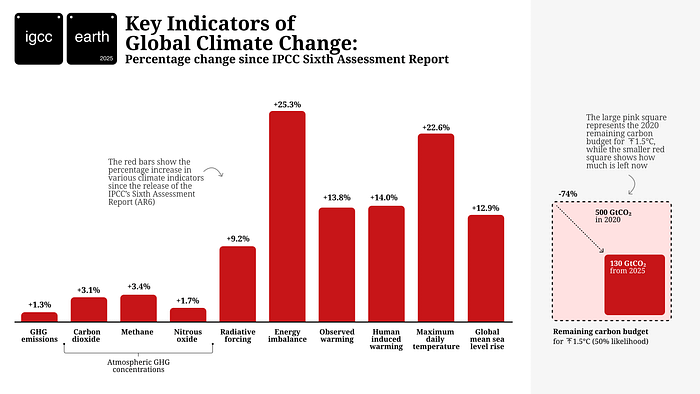
The lagging consequences
So the planet is wrapped in an ever-thickening thermal blanket, one we can’t take off.
And this extra heat is being stored — mostly in the oceans. In fact, the ocean has absorbed about 91% of it so far. You’d think that would be a good thing. A buffer. A blessing.
But it’s more like a trapdoor.
“Warmer waters lead to rising sea levels and intensified weather extremes, and can have devastating impacts on marine ecosystems and the communities that rely on them. In 2024, the ocean reached record values globally,” explains Dr. Karina Von Schuckmann.
Over the past six years, the global sea level has climbed by 26mm — more than double the long-term rate. That may look like a small number on paper. But for low-lying coasts, it’s the difference between a tide and a flood; for hurrican prone cities, between wet sand and a ruined village.
And the trend is accelerating.
Since 1900, we’ve added about 228mm of sea level rise — slowly, yes. But sea level rise is a lagging consequence. It’s the climate’s long game. Even if we stopped burning everything tomorrow, the oceans would keep rising for decades, maybe centuries.
This rise is now making storm surges more violent and coastal erosion more destructive. Entire shorelines are being rearranged, not by design, but by physics. The 2019 IPCC report warned that more than one billion people could be living in vulnerable coastal zones by 2050. Today, that sounds like an underestimate.
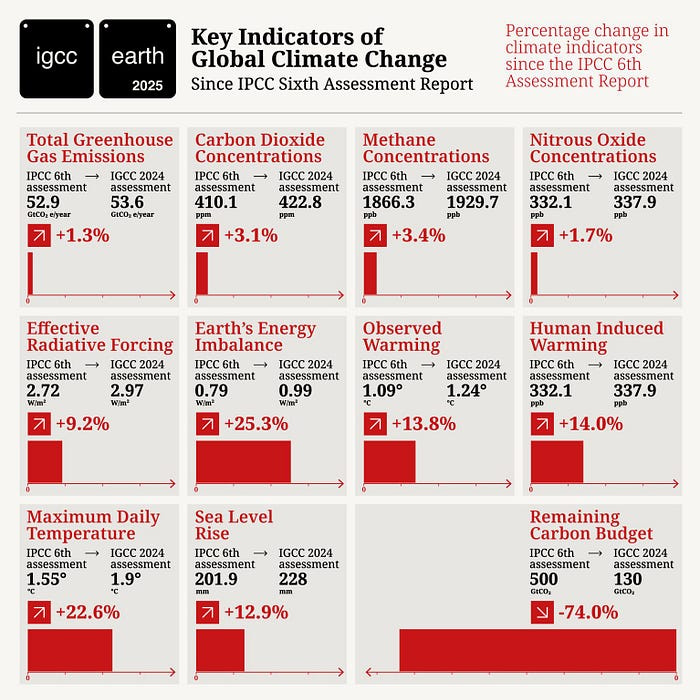
From Apex Predator to Prisoner of Our Own Heat
We’re going to hit 1.5°C of long-term warming soon, probably within a few years. Simply put, modern society isn’t willing to do what it takes, the drastic, transformative actions both in cutting GHG emissions and stopping deforestation — we prefer driving massive trucks, Amazon Prime daily deliveries, and worldwide Starlink connection.
Look out the window and all you’ll find is record after record falling. Yes, back-to-back hottest years on record. But that builds from record warmth in the Atlantic, from glaciers melting faster than ever, from an all-time low global sea ice extent, from fires so massive that they devour a megacity like Los Angeles.
Think of it this way: Breaking weather records used to be like breaking sports records — it should get harder over time as the ceiling moves higher. Instead, hot temperature records that should happen once in a million years are now happening all the time. In the Pacific Northwest, for example, they’ve broken their heat record 14 times in just 75 years — something that should be mathematically impossible without human-caused climate change.
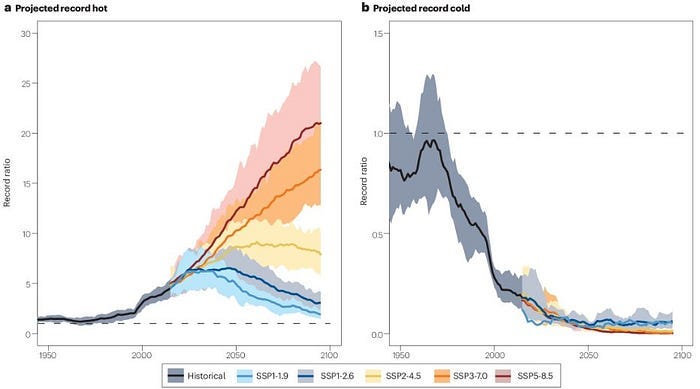
Between 2016–2024, we’ve seen four times more hot records on land than we should have. Rainfall records are up 40%. And those cold days everyone remembers from their childhood are now twice as rare.
The good news is that the pace of global warming controls the occurrence of records. So if we ever slow down global warming, we’ll see fewer of these records broken. The bad news? Well, look at how today’s world operates and tell me if you see a slowdown happening any time soon.
We’ve been told to adapt — that resilience means buying air purifiers, downloading emergency apps, and investing in higher SPF sunscreen, as if the root problem wasn’t the culture of domination that created this crisis.
So what do we do with this chimera we’ve been sold?
We stop pretending it was ever real to begin with. The 1.5°C target was never a plan. It was a PR stunt, a fantasy propped up by carbon offsets, corporate pledges, and the lie that infinite growth and climate stability could coexist.
There’s no pathway to salvation that doesn’t cut through the bones of predatory capitalism, through our addiction to convenience, through our myth of “green growth.” You don’t get a livable planet by swapping engines. You get it by stopping the fire.
And while governments posture, billionaires build bunkers, and corporations launch greenwashing campaigns funded by the very profits destroying our biosphere, we’re left to wonder:
We’ve spent the last decade chasing a number. Now the number is chasing us.
From apex predator to prisoner of our own heat.
So be loud.






I just read this paper myself and was considering how to discuss it. Instead I found this excellent analysis already up. If you want to know what the latest IPCC numbers and positions are this is a good place to start.
Clear as a bell. A hell of our own making. Thank you.